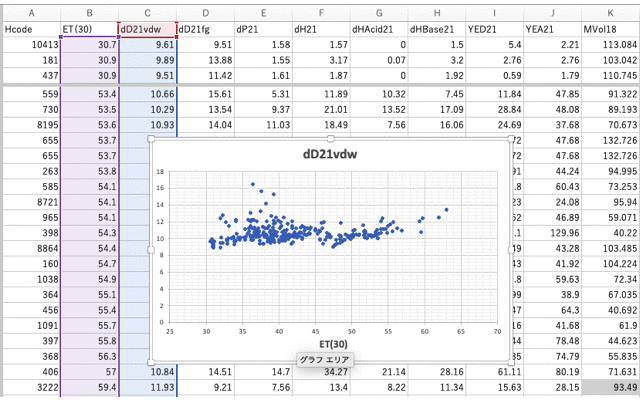Solvatochromism (Wikipedia) is the change in colour of a dye depending on the polarity of the solvent. The polarity of various solvents is summarised as ET(30) values.
So, if you look at what colour a pigment becomes when it is adsorbed in the organism, you can get an idea of the polarity around it.
It may be a layman’s mistake, but does this mean that the polarity of the coronavirus spike area can be determined by looking at the colour of the fluorescent solvatochromic dye?
Then, conversely, if there is a structure (e.g. tryptophan), there may be a need to know how many polarity, ET(30), is around that structure.
As I am developing Hansen Solubility Parameters (HSP), I would like to tell them to use HSP instead of such incomprehensible polarity.
So, I would like to know how the physical property ET(30) is related to HSP.

There are 281 compounds with known ET(30) values in the DB at hand. Using the Smiles structural formula and Y-MB of the compound, various physical properties are calculated.
As ET(30) is originally a polarity parameter, it can be predicted that there will be a correlation with the dP (polarity term) of the HSP if the correlation is displayed graphically.
Next to that, there is a correlation with dH (hydrogen bonding term).
The hydrogen bonding terms can be split into dHAcid and dHbase, so it would be easy to know that there is a correlation with them.
This means that ET(30) depends on both dP (polarity term) and dH (hydrogen bonding term). So, to convert it, the QSAR equation has to be constructed.
YED and YEA are ED (Electron Donor) and EA (Electron Acceptor) indicators created by me, Yamamoto. Originally, they are Gutmann’s DN and AN, but I use them separately because of confusion with dHdo and dHac, which are used in HSPiP.
It was presented at the HSP 50th anniversary lecture five years ago.
At that time, I was struggling to assign these YED and YEA to dH and dP.
This is because HSP theory treats HSP differences between compounds in terms of HSP distances.
Between compounds with exactly the same HSP, the HSP distance is zero.
The assumption is that the same thing is no more soluble than the same thing is soluble in the same thing.
However, in terms of intermolecular interactions, the HSP distance can become negative when donor/acceptor interactions are included. (It can’t be calculated, because the inside of root would be negative.)
So, ED (Electron Donor) and EA (Electron Acceptor) are not currently used because they are not taken to the HSP distance.
However, they are very important parameters and useful for MI/MG/ML etc.
It can be confirmed that the correlation with YEA is very high in this ET(30) case as well.
Let me show what happens if I use MIRAI to create a prediction equation for ET(30).
Normal analysis software works to minimise the square error and to ensure that all data ride as well as possible on the Y=X straight line. (MR: Multiple Regression)
The reproducibility of the region with large ET(30) becomes very poor as follows. (The overwhelming majority of compounds have an ET(30) of 50 or less, so the parameters are dragged in that direction.)

In MIRAI, those that go off can go off even more significantly, so those that ride Y=X are made to behave in such a way that they ride even better.

The data can then be rechecked, although they are largely outliers. (Data cleansing)
For example, if you check what solvents are on the lower side of Y=X, you will find that, for example, alcohols with electron-withdrawing groups are out of place.
| 2-Cyanoethanol | OCCC#N |
| 2,2,3,3-Tetrafluoro-1-propanol | OCC(F)(F)C(F)F |
| 2,2,2-Trifluoroethanol | C(C(F)(F)F)O |
| 1,1,1,3,3,3-hexafluoro-2-propanol | C(C(F)(F)F)(C(F)(F)F)O |
It gives a very good suggestion to consider other mechanisms, even though it is obvious that the calculated values of HSP values, YED, YEA and dipole moments should be checked again.
This means that the measured ET(30) for these compounds is larger than the ET(30) predicted from the calculation. If they form clusters with the OH group inside, as in surfactants, then as an aggregate they become a physical property.
In that case, it is natural that they are displaced.
It seems to me that the places doing MI/MG/ML are pursuing only high correlation coefficients and coefficients of determination, ignoring the fact that it is natural for them to deviate.
Water is also greatly shifted downwards, but it has been investigated by NMR or something that water forms clusters with 13 pieces.
Is there anywhere that can do such a verification?
